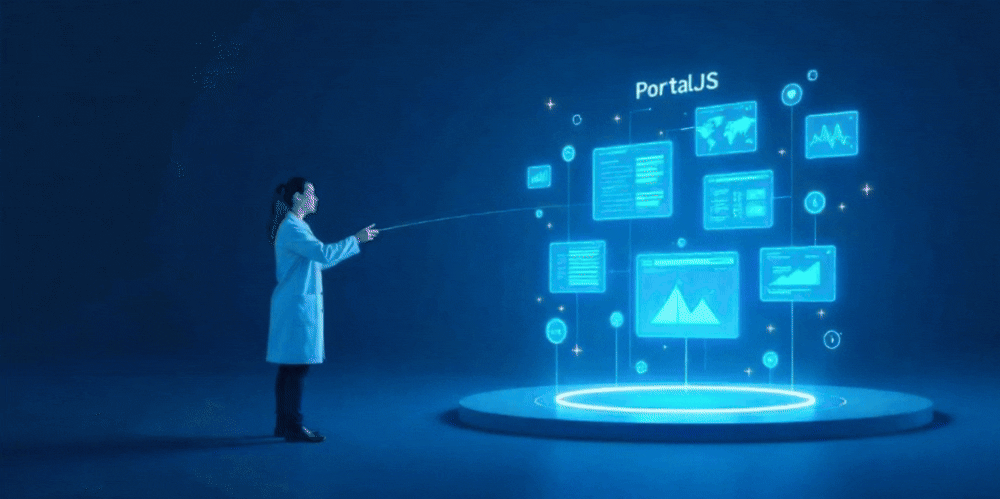Why NASA — and Anyone Using CKAN — Should Consider a Decoupled Front-End with PortalJS
Anuar Ustayev
Yoana Popova
Imagine a Faster, Smarter NASA Data Portal
What if a climate scientist visiting data.nasa.gov could explore global time-series datasets through an interface that loads instantly, adapts to their workflow, and feels intuitive—on any device? Today, NASA’s portal runs on CKAN’s built-in frontend, which serves its purpose but limits performance and flexibility. By adopting a decoupled frontend using PortalJS, NASA could dramatically improve speed, user experience, and accessibility—without changing the backend. This shift unlocks a more modern open data experience, tailored for researchers, analysts, and developers working with large, complex datasets.

The Current CKAN-Based Approach
NASA’s portal uses CKAN’s built-in frontend — a unified structure where the user interface and backend are tightly connected.
Monolithic UI & API
CKAN’s integrated UI and backend deliver robust search and data-management workflows out of the box. It serves well for dataset CRUD, geospatial previews, and basic theming.
What Works:
- Out-of-the-box dataset management
- Geospatial previews
- Basic theming and search
Limitations
- Release Cycle Coupling: UI updates often require CKAN core upgrades or plugin rebuilds.
In simple terms
If you want to tweak the interface, you have to dig into the backend code. That slows things down and makes small changes more complicated than they should be.
- Branding Constraints: Deep theming adjustments can be labor-intensive and risk conflicts with upstream.
In simple terms
Making your portal look like “NASA” (or any other organization) takes a lot of effort, and those changes may not survive future updates.
- Performance Overheads: Server-side rendering for every page load can introduce latency under heavy traffic.
In simple terms
Every time someone opens a page, the server has to rebuild it. That slows things down when lots of people visit at once.
Why a Decoupled PortalJS Front-End?
PortalJS is a frontend framework purpose-built for CKAN. PortalJS consumes CKAN’s REST API and renders the frontend independently using Next.js. This architecture gives teams more control over UX, while keeping the backend untouched.
Key advantages:
1. Rapid Iteration
PortalJS applications consume CKAN’s REST APIs, enabling independent deployment of UI components. New features — like custom data-visualization panels — can ship without touching the CKAN codebase.
2. Enhanced UX & Branding
- Component Library: Reusable “DatasetCard,” “FilterPanel,” and “MapExplorer” snippets conform to NASA’s design system.
- Responsive & Accessible: Built-in patterns for ARIA compliance and mobile-first layouts ensure broad reach.
In simple terms
You can make the portal look and feel exactly how your users expect, with reusable building blocks. Works well on phones and meets accessibility standards by default.
3. Scalability & Resilience Scalability & Resilience By hosting the PortalJS front end on a CDN (e.g., Cloudflare) and separating it from CKAN servers, static assets load faster and UI downtime can be decoupled from backend maintenance windows.
In simple terms
Pages load almost instantly because they’re already generated and stored near your users — no waiting for the server to respond.
A Blueprint for Decoupled Architecture
A decoupled setup keeps CKAN as the backend and places PortalJS on top as the user-facing layer. The backend stays stable, while the frontend can evolve quickly and scale independently. You serve pages fast, keep your infrastructure lightweight, and give teams more control.
1. API Gateway:
- AWS API Gateway or CloudFront Lambda@Edge enforcing API keys, rate-limits, and caching for CKAN REST endpoints.
2. PortalJS Application:
- Deployed to an S3 bucket + CloudFront distribution.
- Integrations: CKAN’s /api/3/action routes for dataset search, resource download, and user authentication.
3. Extensibility Hooks:
- Widget Registry: Dynamically load visualization widgets (e.g., D3 timelines, Cesium 3D maps) based on dataset metadata.
- Theme Manager: Allow NASA web teams to tweak color tokens and font scales via a JSON config file.

Why This Matters
CKAN’s backend is solid. But a modern frontend makes ALL the difference.
This isn’t just about NASA. The same constraints exist for many governments, research labs, and institutions using CKAN.
Decoupling with PortalJS unlocks:
- Speed
- Flexibility
- Custom and modern UX
- Resilient architecture
Bottom line
Your portal can grow, adapt, and look modern — without expensive rebuilds or risky changes to your data backend.
See It in Action
Curious what this would look like for your team? Start a pilot in minutes — no backend changes required.
If you’d like to explore a PortalJS pilot on your CKAN instance — government, research institution, or enterprise — visit our site and get started in minutes!
📩 Talk to us to discuss your use case.